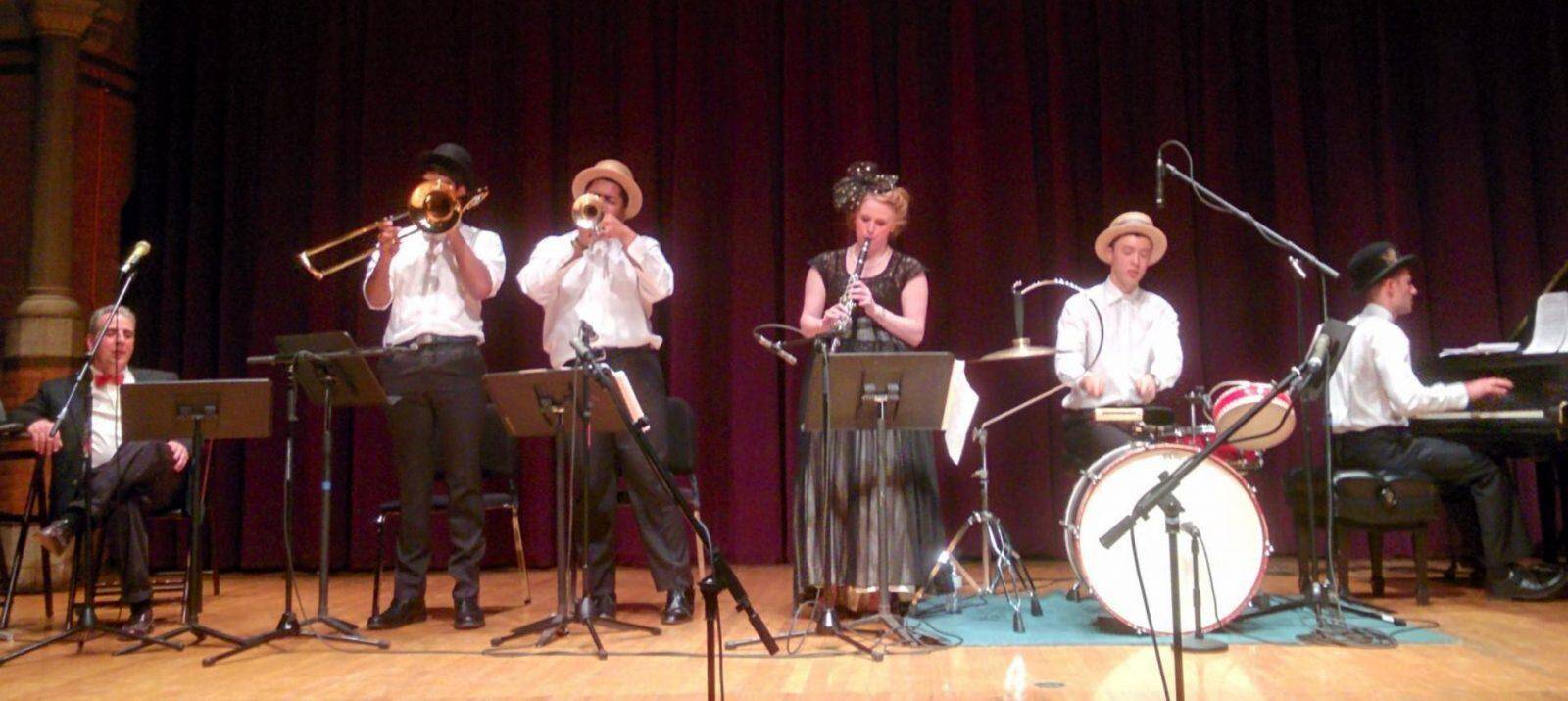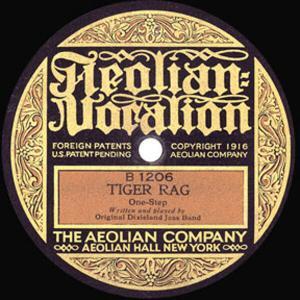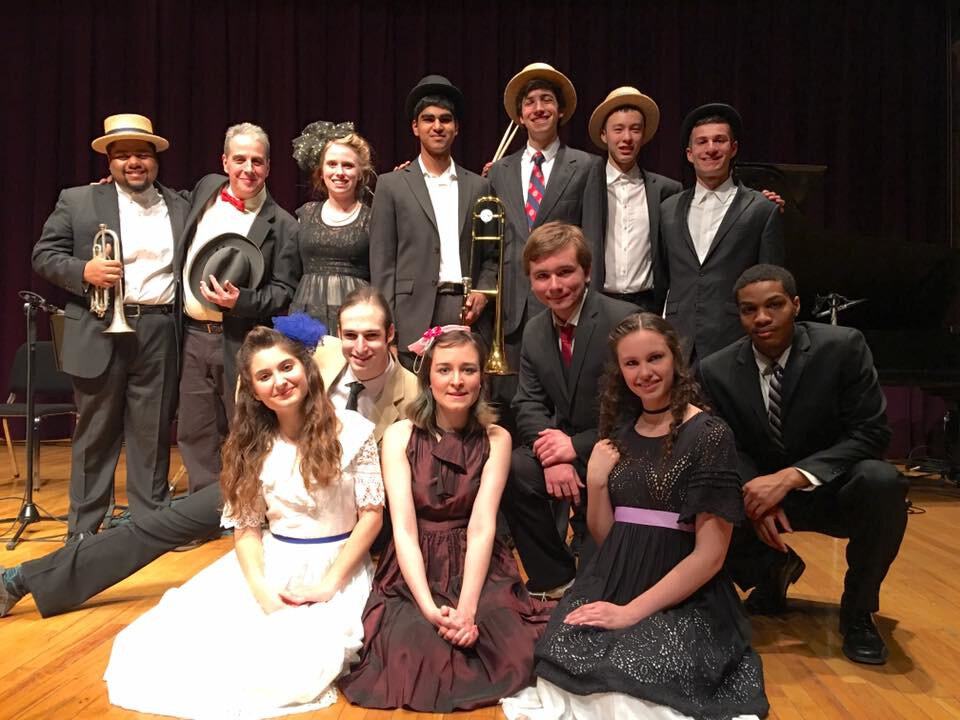February 26, 2017 is widely, though not universally, recognized as the 100th anniversary of the first recorded jazz. The day was commemorated with many concerts and events across the country, and properly so. Any record that outsold Caruso and Sousa in that day is justifiably epochal.
I did my part by traveling to Ithaca, New York to see the Original Cornell Syncopators re-create not only the titles that were issued about ten days later as Victor 18255, but the scene that might have occurred at the Columbia, and then Victor, studios as well as at Reisenweber’s Cafe in New York, where the Original Dixieland Jass Band performed before going into the studio. The ODJB first recorded at Columbia, but the results were not good enough (in Columbia’s judgment, at least) to release, and the masters were scrapped. Logistical problems at the studio may have spelled their doom rather than their aural quality.
The OCS was profiled in the December TST, so I need not repeat how the band came to exist. It was that article that led me to put this concert on my calendar. It was held in Barnes Hall on the Cornell campus, a building dating from 1889 and housing an unusual-looking (though perhaps not unusual for that era) theater with about 250 seats. There are tiered rows of seats on three sides facing the stage, but the view from the flanks is, naturally, not nearly as good as from the section facing the stage. Most of the audience of approximately 100-125 figured that out, so the side sections were largely empty.

The audience for this concert was comprised, it appeared, largely of Cornell students, with a few non-campus visitors such as myself, your publisher, and his wife, and a few other adults, some of whom may have been band members’ relatives or members of the upstate Jazz community. It would be gratifying to think that all the students were there because of a love of this music, and many from the Jazz Ensembles were, but I suspect that a requirement for music majors to attend might have been a more compelling factor for a few others. In any case, the concert was enthusiastically received by all, and that is a tribute to the attendees as well as to the band.
The theater has mostly brick walls with a vaulted ceiling. I initially wondered how good its acoustics would be, but if the hall has been deemed fit for concerts for over 125 years, the results must be satisfactory to people who know far more than I do about sound.

The program was short—less than an hour including an intermission. The first segment was “A Night at Reisenweber’s,” in which the band played five numbers that the ODJB might have played (and probably did) at the cafe prior to making their first record, and recorded later in 1917 for the Aeolian-Vocalion label on rare vertical-cut discs. These were: “Tiger Rag,” “Ostrich Walk,” Look at ’Em Doing It,” “Soudan/Oriental Jazz,” and “At the Jazz Band Ball,” all but “Soudan” having been written in 1917. On several numbers the Crazeology dance troupe in period costumes, seated at small tables to one side of the stage, danced in front of the band.
Act II reprised the numbers—“Livery Stable Blues” and “Dixie Jass Band One-Step,”—which appeared on #18255; and “Darktown Strutters Ball” and “Indiana,” both also written in 1917. The stage was set up with a mock recording studio to one side, first draped with a Columbia banner, then with Victor’s logo, with an “engineer” counting down the start of the recordings.
For both sets, Joe Salzano, the band’s coach and a jazz veteran in that part of New York State, served as the announcer, informing the audience of the history of the ODJB. Paul Merrill, Cornell’s Jazz Director, played the part of both the Columbia and Victor recording engineers respectively, while Troy Anderson (a future member of the band) played a cameo role as the deliverer of the telegraph letting the band know of Victor Records’ intentions to record them. Merrill also deserves a shout-out for his help in searching for enthusiastic students to populate the band. Colin Hancock, the band’s founder and leader, has also drawn help from jazz stalwarts well known to TST readers—Dan Levinson, David Sager, and Hal Smith.
Dan, whom I know quite well and whose opinion I value highly, told me that I would not be disappointed by what I heard from the OCS. He was right. I was so impressed that I’m now in discussion with Colin to bring the band to the Tri-State Jazz Society in 2018. I look forward to an expanded (to 8 or maybe 11 pieces) OCS that will present the repertory of notable ’20s bands such as the Wolverines and New Orleans Rhythm Kings. Colin will be guesting with Dan Levinson’s Roof Garden Jass Band at Tri-State on September 24, so rather than have the OCS duplicate that program, I would ask them to feature their expanded book of these later bands.
The OCS has come a long way in the year (or less) since its founding. All but one of its five members are sophomores, so they should be around for at least another two years. Who knows: even after the current members graduate, they may still want to get together for gigs. We can hope.
Related: “Ain’t That Hot!” The Original Cornell Syncopators Romp in Ithaca/ Colin Hancock: Bolden and Beyond/ Introducing the Original Cornell Syncopators
Bill Hoffman is a travel writer, an avid jazz fan and a supporter of musicians keeping traditional jazz alive in performance. He is the concert booker for the Tri-State Jazz Society in greater Philadelphia. Bill lives in Lancaster, PA. He is the author of Going Dutch: A Visitors Guide to the Pennsylvania Dutch Country, Unique and Unusual Places in the Mid-Atlantic Region, and The New York Bicycle Touring Guide. Bill lives in Lancaster, PA.





















